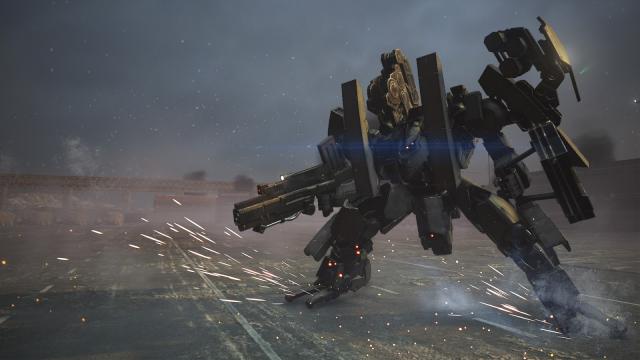Left Alive is not a very fun game to play. Its mashup of stealth gameplay and mech combat is clunky and frustrating. But these gameplay shifts do create spectacular contrasts that capture one of the most important features of the giant robot genre: the human costs of mech combat.
In Left Alive, the outbreak of a sudden war between two fictional European countries is worsened by the use of massive robotic weapons called Wanzers. Wanzers are large, stompy mechs stockpiled with missile pods, grenade launchers, and other dramatic weapons.
The natural outcome of creating giant mechs with excessive weaponry is the complete and utter devastation of whatever warzone they enter. Left Alive focuses on on navigating those spaces, particularly in the segments where you play as Staff Sergeant Mikhail Shuvalov, a pilot shot down in the middle of a massive city.
His segments are focused on surviving behind enemy lines, scavenging for items to use as makeshift weapons, and finding ways to rescue his fellow soldiers. Through his segments, players navigate fallen buildings and flame-engulfed streets. They meet civilians who are shocked and left all but broken as their homes crumble around them.
And while you use a partially functioning mech’s guns to survive in the first mission, it’s not until later that you finally pilot a Wanzer.
One of the most important things mechs do in the giant robot genre—at least in stories that skew more realistic—is depersonalize the nature of war. The mechs physically and emotionally insulate pilots from the chaos they cause. Pilots blow up other mechs with reckless abandon and without the bloody intimacy of seeing the person they are killing.
Much like how drone operators are removed from the effect of their actions in real life, mech pilots are often shielded from the carnage that they cause in their giant death robots. Only whenthose robots and their layers of protection break down do the ramifications of large-scale combat become evident.
This is why some of the most striking scenes in the giant mech genre, such as the finale of Mobile Suit Gundam 0080: War in the Pocket, show us the perspective of civilians. And this is why it is so important that Left Alive devotes the majority of its gameplay to crawling through wrecked cities and oppressive slums.
When Mikhail or other character manage to climb into a Wanzer’s cockpit, it’s a moment of triumph. Left Alive’s design disempowers the player both intentionally and due to its various shortcomings. It’s a difficult game where it is easy to die; getting a Wanzer changes that.
The music swells as the player marches forward, blowing up mechs, causing havoc, and killing waves of soldiers. That triumph is undercut by what we’ve already seen; even though we survived and struck back after being at a disadvantage, we’re rapidly creating more of the destruction we just struggled through.
Left Alive doesn’t render all of the damage, but the contrasting forms of play help sell it. For a game that’s otherwise messy, it’s a real achievement that shows an understanding of what makes giant mechs so compelling.

Comments
3 responses to “Left Alive Isn’t Fun But Its Depiction Of Mechs Is Great”
I think the most challenging thing for anyone involved in this conflict (and as has been the case for all the Front Mission games) is saying “Wanzer” with a straight face.
I would finish the article but you know an enemy is approaching..
Yea watching Heather stream this on Easy difficulty showed me how bad the game was. At least the stream was entertaining though.